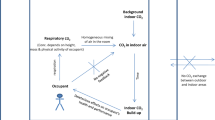Abstract
Recent studies have shown the effect of internally generated pollutants in closed rooms equipped with split air conditioners on human health. The split air conditioner does not filter the carbon dioxide (CO2) and at the same time, the air conditioner recirculates the filtered air within the room itself when the rooms are closed. At nights the doors and windows are closed over 6 to 8 hours hence CO2 levels tend to increase. This results in acute health condition known as Sick Building Syndrome (SBS). The research proposes the methodology that partial opening of window will infiltrate outside air inside the room. This helps in reducing the levels well below the threshold value. Effect of varying occupancy in room and percent opening of window on CO2 level is reported. The increase in CO2 level is seen to be very less (55% rise) with 100% opening of the window in comparison with 0% ventilation (721% rise). However opening the window may lead to increase in energy consumption in case of air conditioned room. Therefore, an alternative method of using snake plants to reduce CO2 levels in a closed room is also reported. The comparison study of snake plants proves its efficacy by reducing the percentage increment in CO2 levels by the factor of 0.5.








Similar content being viewed by others
Abbreviations
- CO2 :
-
Carbon Dioxide
- ASHRAE:
-
American Society of Heating, Refrigerating and Air-Conditioning Engineers
- IAQ:
-
Indoor Air Quality
- PM:
-
Particulate Matter
- SBS:
-
Sickness Building Syndrome
- WHO:
-
World Health Organization
- PPM:
-
Parts Per Million
- CAM:
-
Crassulacean Acid Metabolism
- REM:
-
Rapid Eye Movements
- NREM:
-
Non-Rapid Eye Movements
References
Wong N H and Huang B 2004 Comparative study of the indoor air quality of naturally ventilated and air-conditioned bedrooms of residential buildings in Singapore. Journal of Building and Environment. 39: 1115–1123
Ramalho O, Wyart G, Mandin C, Blondeau P, Cabanes P, Leclerc N, Mullot J, Boulanger G and Redaelli M 2015 Association of carbon dioxide with indoor air pollutants and exceedance of health guideline value. Journal of Building and Environment. 93: 115–124
Asif A, Zeeshan M and Jahanzaib M 2018 Indoor temperature, relative humidity and CO2 levels assessment in academic buildings with different heating, ventilation and air-conditioning systems. Journal of building and environment. 133: 83–90
Seppänen O A, Fisk W J and Mendell M J 1999 Association of Ventilation Rates and CO2 Concentrations with Health and Other Responses in Commercial and Institutional Buildings. Journal of Indoor Air. 9: 226–252
Satish U, Mendell M J, Shekhar K, Hotchi T, Sullivan D, Streufert S and Fisk W J 2014 Is CO2 an Indoor Pollutant? Direct Effects of Low-to-Moderate CO2 Concentrations on Human Decision-Making Performance. Journal of Environmental Health Perspective. 120: 1671–1677
Sulaiman Z and Mohamed M 2011 Indoor air quality and sick building syndrome study at two selected libraries in Johor Bharu. Malaysia. EnvironmentAsia. 4(1): 67–74
Erdmann C A, Steiner K C and Apte M G 2002 Indoor carbon dioxide concentrations and sick building syndrome symptoms in the base study revisited: analyses of the 100-building dataset. Indoor Environment Dept., Lawrence Berkeley National Laboratory, Berkeley, CA, USA
Patel S, Miao J H, Yetiskul E, Anokhin A and Majmundar S H 2022 Physiology, Carbon Dioxide Retention. [Updated on January 2, 2022], StatPearls [Internet]. https://www.ncbi.nlm.nih.gov/books/NBK482456/
Hussin M, Ismail M R and Ahmad M S 2017 Air-conditioned university laboratories: Comparing CO2 measurement for centralized and split-unit systems. Journal of King Saud University- Engineering Sciences. 29: 191–201
Pantazaras A, Santamouris M, Lee S E and Assimakopoulos M N 2018 A decision tool to balance indoor air quality and energy consumption: A case study. Journal of Energy and Buildings. 165: 246–258
Lohani D, Barthwal A and Acharya D 2022 Modeling vehicle indoor air quality using sensor data analytics. Journal of Reliable Intelligent Environment. 8: 105–115
Passi A and Maiya M P 2021 Characteristics of indoor air quality in underground metro stations: A critical review. Journal of Building and Environment. 198: 107907
Heide V, Skyttern S and Georges L 2021 Indoor air quality in natural-ventilated bedrooms in renovated Norwegian houses. E3S Web of Conference on Cold Climate HVAC & Energy. 246: 01001
Wolverton B C, Douglas W L and Bounds K 1989 A study of interior landscape plants for indoor air pollution abatement. NASA, NASA-TM-108061
Pachauri G, Bugasara P S, Yadav M, Khan M A A and Maheshwari R K 2017 Snake Plant (Sansevieria Trifasciata): Imminent Classically Versatile House Indoor Detoxifier. Journal of Biological and Chemical Research. 34: 923–927
Forseth I 2010 The Ecology of Photosynthetic Pathways. Knowledge Project. Nature Education. Retrieved 2021-03-06
Klaus W and Smith J A C 2021 CAM photosynthesis: The acid test. New Phytologist. 233: 599–609
Choudhary S and Choudhary S R 2009 Sleep effects on breathing and respiratory diseases. Lung India. 26(4): 117–122
Gutierrez G, Williams J, Alrehaili G A, McLean A, Pirouz R, Amdur R, Vivek J and Jalil A 2016 Amandeep B and Shawn K 2016 Respiratory rate variability in sleeping adults without obstructive sleep apnea. Physiol Rep. 4(17): e12949
Patel S and Majmundar S H 2019 Physiology, Carbon Dioxide Retention. [Updated 2019 Jun 3]. StatPearls [Internet]. Treasure Island (FL), StatPearls Publishing, https://www.ncbi.nlm.nih.gov/books/NBK482456/
Author information
Authors and Affiliations
Corresponding author
Rights and permissions
About this article
Cite this article
Patil, V.S., Nandurdikar, V., Shelar, M.N. et al. Experimental investigation of CO2 level in the closed room including the effect of ventilation and use of snake plants. Sādhanā 48, 49 (2023). https://doi.org/10.1007/s12046-023-02094-3
Received:
Revised:
Accepted:
Published:
DOI: https://doi.org/10.1007/s12046-023-02094-3




